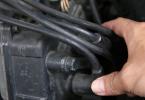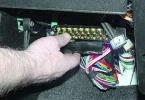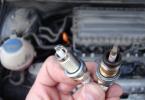Working lubricant hydraulic power steering, like any other lubrication, with time it becomes unusable. Consider the resource of the technical fluid, as well as describe in detail how to change the oil in the power hydraulicel and how much it costs to pour lubricants for the operation of the system.
Resource
Some manufacturers of GUR argue that oils in their systems are flooded for the entire service life, so the replacement due to aging and the loss of properties is not needed. It is necessary to change the oil only in the case of technical works affecting the hydraulic strengthening system. Of course, if the level "leaves", it is worth the topical.
We want to assure you that if you are expensive, the maintenance of your car, replacing the fluid Gur - the mandatory component of the maintenance. It is recommended to change the oil every 100 thousand km. either 4-5 years of operation.
If you do not know how often and when the oil changed for the last time, it is necessary to navigate on the condition of the liquid. Dark color, mud impurities, grown smell - clear reasons to replace lubricating composition.
In some steering tanks, a mesh for filtering is installed. The dirty liquid is capable of scoring the pores, which worsens the bandwidth, it makes it possible to circulate fluid throughout the system. It feels the high level of noise of the pump of the pump GUR, and more effort is required for the rotation of the steering wheel.
Filling volume
Information on how much oil is flooded in the GUR of your car (and how often it needs to be changed), you can learn from the technical documentation for use. Note that part of the filling volume when replacing with your own hands, in any case, will remain in the system. Depending on the selected replacement method, this indicator varies from 5-20%.
If you do not have any materials on your hands, you can navigate the amount of fluid that it will be done to merge. Usually replacing the power of the water car power steering vehicle requires no more than 1 liter oil. How many lubricants will need, also depends on the method of replacement.
Control of quantity
The fluid level of the GUR can be checked in two ways:
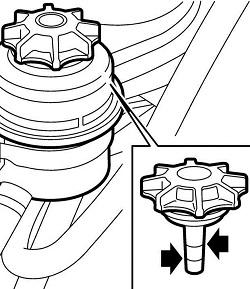
Method of partial replacement
The first method of replacement with your own hands is the most simple, but at the same time more costly from the point of view of the financial component. To replace the oil, you will need:
- double volume of refueling liquid;
- the syringe with the hose, the length of which will reach up to the bottom of the tank of the power steering;
- capacity for draining testing.
Change the fluid GUR can be as follows:
- with the help of a syringe and a hose dressed on it, throw out the maximum possible amount of the liquid from the tank;
- next, it is necessary to add new oil;
- overcome as usual about 100 km.;
- repeat the procedure until the GUR does not change the color to overcome the specified kilometer. This will be a signal that the system is completely cleaned from old contaminants.
This method is most favorable because it allows you to rinse the entire system well. But it requires more lubricants and time costs. A simplified method of partial replacement involves mixing the old and new oil by rotating the steering wheel (the machine is on the spot). To do this, after the fill of the new oil, rotate the steering wheel to the left, delay in this position 2-3 s., Then turn the wheels in the opposite direction, withstanding the same pause. The number of repetitions for each case individually. To facilitate life Pump GUR, post the front axle of the car.
This method is more acceptable if you need to change the lubricant on the car, where access to the feeds of the supply and fluid feed rods is difficult. 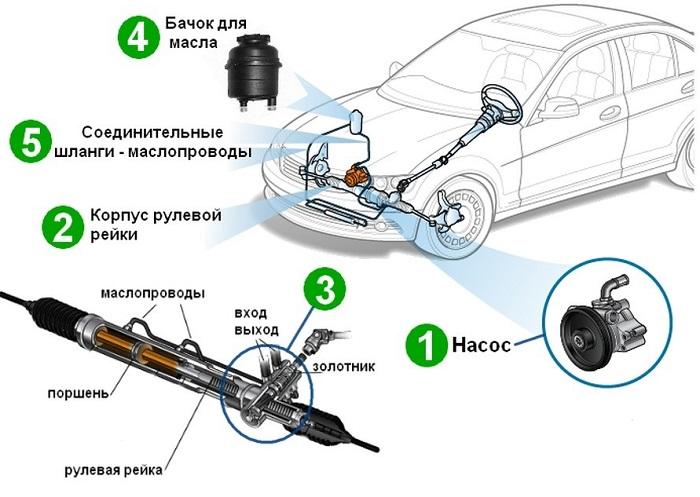
A bit of theory
It is impossible to correctly change the GUR oil below the method described, without having knowledge about. Those in our case there will be knowledge that the liquid is closed from the tank into the pump for pumping into the rail, the steering gearbox; After completing the useful operation, the lubricant returns through the line of returns to the tank.
Tools and materials
Replacing with your own hands is impossible without the next set of tools:
- passatia;
- plug for hole in the tank under the return hose;
- capacity for the drain of the old liquid;
- syringe and hose;
- jack and supports for safe hanging front axles.
Replace the GUR oil will be easier if you invite assistants. The use of an air compressor will help drive out of the system more old liquid.
Replacing one smear
- Pour all the liquid from the tank with a syringe and hose. Remove the tank and rinse it well;
- the backbone hose is lowered into the container. Establish it so that the old fluid does not spill during the drain process;
- post the front axle of the car;
- remove the steering wheel to the left left, then in the opposite direction. Repeat the procedure until the old lubricant stops from the loaf hose. For an even better result, pull the fuse of the fuel pump or remove the ignition coil, and then screw the engine starter not more than 10 s. With small intervals, repeat the procedure several times. It is not worth starting the engine, since work without lubrication can negatively affect the rubbing elements of the pump. In the presence of a compressor, briefly serve in the supply of compressed air lubrication lubrication hose. This will help to get rid of the old fluid as much as possible. Be careful because the pressure can lead to splashing of the liquid;
- install the tank and connect the hoses;
- now it is necessary to add a new liquid, leave the lid open;
- ask the assistant either ownly twist the steering wheel until it stops left and right. At first, it does not matter how much you will pour fluid, as it will go to fill the system. If you want to correctly change the power steering fluid, do not allow the tank to be allowed. This will lead to a trusting of the system;
- when the level stops decreasing, start the engine. Continue the rotation of the steering wheel with low delays in the extreme position until the air will stop out the system.
Alternative method
When you execute item 2, install the tank and drain the reversal hole in it. We will change the liquid without merging the entire old lubricant. Fill new oil. Now you need to rotate the steering, as described above, and replenish the level in the tank until the old lubricant arising from the loose hose is not replaced by a new one. Many believe that the fluid of the GUR is more correctly changed, since the "replacement is one fell" method leads to the fact that the system is often delivered.
